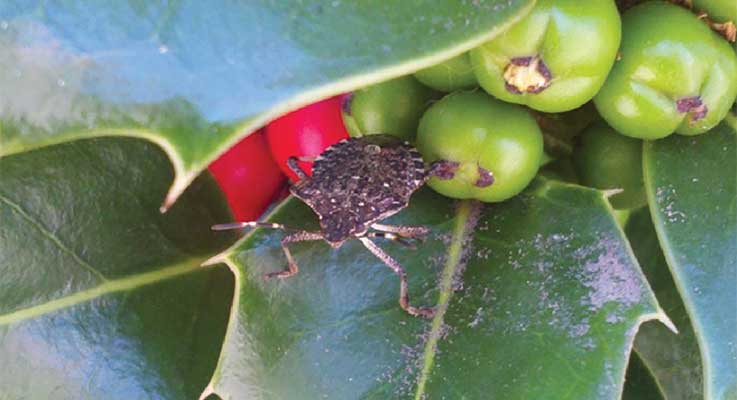This costly and annoying pest has few barriers to its growth in Oregon

English holly is a common ornamental that is a reproductive host of brown marmorated stink bug in Oregon.
Brown marmorated stink bug (BMSB), Halyomorpha halys, is an important invasive pest most known for its economic impacts on fruits, vegetables and agronomic crops. However, urban nuisance problems are also associated with this pest.
High populations of the pest build up throughout the growing season on ornamental plants within the urban landscape. They become abundant in outdoor living spaces, devastate home gardens, and may migrate into adjacent commercial agricultural lands.
The overwintering behavior of BMSB is what makes the pest most despised by homeowners.
Aggregations of adult BMSB form on homes starting in late August and last through November. These BMSBs are searching for suitable refuge to spend the winter months. They are commonly found crammed into gaps around windows, in or under siding, or if they are able to penetrate through the exterior walls, they may be found within interior spaces such as attics.
Throughout the winter, and particularly as spring approaches, BMSB in interior spaces may be influenced by warm temperatures in homes and become active. They fly around inside and can cause great distress to homeowners. Tens of thousands of insects can occupy a single house over the winter.
When numbers reach this density, defecation by the bugs can tarnish walls, and carcasses of the dead BMSB can cause secondary pest problems with insects such as dermestid beetles that arrive to feed on the dead BMSB.
Obviously, there are other costs — including homeowner sanity.
Management options for homeowners
For homeowners affected by these problems, there are few management options. Perimeter or landscape sprays can offer temporary relief, but this pest is very difficult to control chemically and the problem often returns.
One potential management strategy that has received some attention, particularly in the Mid-Atlantic region of the U.S. — where urban nuisance problems from BMSB are severe — is to design landscapes to be BMSB resistant.
Homeowners in the Willamette Valley and other areas of Oregon are also beginning to experience severe infestations of BMSB in their home and may also have incentive to design BMSB-resistant landscapes.
In a new landscape planting, species selection is made on the basis of host plant quality for BMSB, and plants that are favored by the pest are avoided. In an established planting, this could involve removing host plants from the landscape that are facilitating the population buildup and replacing them with plants that are poor BMSB hosts.
Clearly this is only an acceptable solution if the landscape can be manipulated. Neighboring vegetation can still influence BMSB populations in or around the home.
Host plants in production
The list of U.S. host plants for BMSB is extensive, with approximately 170 plants listed as acceptable hosts (see: http://www.stopbmsb.org/where-is-bmsb/host-plants/). These host plants can be separated into categories including wild, ornamental and crops, and further categorized into reproductive or transitional hosts.
Reproductive hosts are acceptable to all BMSB life stages and thus contribute the most to population increase, whereas transitional hosts may be used for a limited part of the season.
Many of the most important host plants for BMSB are produced in Oregon nurseries. Recent research from the University of Maryland demonstrated that the plants most likely to host BMSB are deciduous trees that produce seeds or fruits. The insects use these reproductive tissues to supplement vegetative feeding.
Persistence of these food sources on the host plant may be a factor for their relative risk for BMSB attack and population increase. Some of the more common species produced by Oregon nurseries that fit this category include dogwoods, maples, pears, cherries, magnolias, basswood and buckthorn. All of these plants have been found to be excellent BMSB hosts in Oregon.
Other common ornamentals that are important reproductive BMSB hosts in Oregon include English holly, Catalpa, Paulownia (empress tree), hazelnut, ash, mountain ash (Sorbus) and Oregon grape. The pests are less often found in conifers, oaks and grasses.
Oregon is the largest exporter of nursery stock in the U.S., supplying many of the plants that go into landscapes nationwide including the Mid-Atlantic region.
As the BMSB problem continues to increase across the U.S., will the design of stink bug–free landscapes catch on and affect our industry? This remains to be seen, but the concept of stink bug–resistant landscapes is sure to catch on among the homeowners who are inundated annually with thousands of the pests.
Agricultural producers are learning to manage BMSB, mostly with insecticides, but fewer management options exist for managing pests like BMSB in an urban environment.
Finding a natural enemy to control stink bugs
Some hope is on the horizon in the form of minute parasitic wasps that attack the eggs of BMSB. In Asia, where the pest originates, these parasitoids largely keep BMSB populations in check.
Researchers have been carefully evaluating these parasitoids in quarantined facilities across the U.S. for possible release against BMSB, while simultaneously surveying natural enemy activity in the field.
While we have found that a number of our native stink bug egg parasitoids readily attack BMSB eggs, they are overcome by the immune response of the developing BMSB embryos and do not develop successfully.
Recently, one of the Asian parasitoid species being evaluated in quarantine has been found outside of quarantine after arriving independently on U.S. shores. This parasitoid is predicted to ultimately spread across the country and will ultimately help bring populations of BMSB under control.
For now, the pest has almost no natural enemies and few environmental limitations, particularly in the Willamette Valley, where winters are mild. In the meantime, stink bug problems are predicted to continue escalating.


